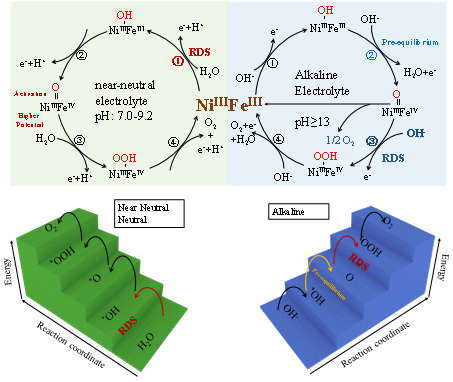Renewable electricity driven water splitting offers a green and sustainable way to produce hydrogen (H2). The key to improving the water splitting efficiency is an efficient electrocatalyst. Non-noble nickel iron (NiFe)-based electrocatalysts are among the best catalysts for OER in alkaline electrolytes. However, they show much lower activity in neutral pH conditions, which limits their application in seawater splitting and CO2 reduction. Despite that many works on NiFe-based electrocatalysts have been reported, their poor OER performance and detailed mechanism in neutral pH electrolytes remain to be discovered. To obtain a fundamental understanding of the mechanisms and functionalities of NiFe electrocatalysts, it is essential to elucidate their compositional and structural changes during the OER process.
Recently, our center in collaboration with Dr. Jingshan Luo's group of the Nankai University, reported the research on the OER mechanism of NiFe based catalysts in different pH electrolytes. This work presented a systematic electrochemical and operando spectroscopy study of NiFe LDH for OER in different pH electrolytes. The NiFe LDH catalysts showed a clear pH dependent OER activity. Operando/ex-situ Raman spectroscopy indicated the formation of Ni3+ species requires higher potential in neutral and near-neutral conditions than in the alkaline electrolyte. The operando 57Fe Mössbauer spectra results also confirmed that Fe4+ species are difficult to form or generated at the more positive potential in neutral or near neutral conditions, compared to NiFe LDH in alkaline conditions.
In addition to the different feasibility for forming high-valent Ni3+ and Fe4+ species, the rate-determining step (RDS) of NiFe LDH for OER was also different in different pH conditions. In alkaline conditions, the barrier for the *OH adsorption and formation of *O is reduced, and the transformation of *O to *OOH is the RDS, leading to a high OER performance. While in a neutral medium, the *OH adsorption is the RDS.
Our results provide new insights for understanding the OER mechanism, and will promote the design of highly efficient electrocatalysts for water oxidation.

Proposed mechanism of NiFe LDH electrocatalyst for OER in different pH electrolytes.
The relevant research results entitled “Investigation of nickel iron layered double hydroxide for water oxidation in different pH electrolytes” has been published in Chinese Journal of Catalysis. And this work was supported by the National Key Research and Development Program of China (2019YFE0123400, 2018YFB1502003), the Excellent Young Scholar Fund from the National Science Foundation of China (22122903), the Tianjin Distinguished Young Scholar Fund (20JCJQJC00260), and the “111” Project (B16027), the scholarship from the China Scholarship Council, the Gebert Rüf Stiftung under Microbials scheme ‘Solar‐Bio Fuels’ (GRS‐080/19), the Early Postdoc Research Fellowship from the Swiss National Science Foundation (P2ELP2_199800), National Science Foundation of China (21961142006), and the International Partnership Program of Chinese Academy of Sciences (121421KYSB20170020).
DOI: 10.1016/S1872-2067(22)64190-1
Relevant link: https://doi.org/10.1016/S1872-2067(22)64190-1